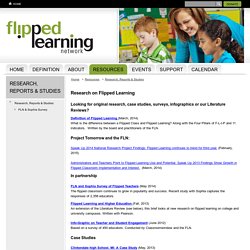

10 Pros And Cons Of A Flipped Classroom. 10 Pros And Cons Of A Flipped Classroom by Mike Acedo Many of us can recall instances in our lives where we found ourselves idly sitting in a classroom, eyes glazed over, half listening to our teacher as they lectured in front of the room.

These scenes are all too familiar in today’s schools, as the traditional model of learning has primarily revolved around a teacher-centered classroom, where instructors focus on conveying information, assigning work, and leaving it to the students to master the material. Though effective for some, this type of instruction has forced students to be merely receptors of information, rather than participants in their own learning processes through active learning. Fortunately, as technology has increasingly grown and infiltrated our classrooms, a new learning model has emerged that moves away from a teacher-centered space, and onto a more collaborative, student-centered learning environment, by way of a flipped classroom. The Pros 1. 2. 3. 4. 5. The Cons 1. How the Flipped Classroom works. The Active Class » Blog Archive » “Flipping” your classroom. When I talk to people about education reform — about doing innovative things like using clickers and peer instruction, or interactive demonstrations, or small group work, a lot of instructors balk.

How can I give up that much lecture time? We have a lot to cover.Students don’t do the reading — so they’re not able to discuss the material yet, they’re starting from scratch. One great solution to this is called Flipping the Classroom. The “flip” has to do with where the content is presented. The standard instructional model is something like this: But that leaves the toughest part — applying the ideas to homework and problems — to students, struggling on their own. The flipped classroom is one answer to that. I feel like the fully flipped classroom, with the lecture time used exclusively for hands-on and interactive work, is likely to continue to be more of a draw in K12 education. The Flipped Class Network Bergmann and Sam’s website. Technology-Rich Learning:Evidence on Flipped Classrooms Is Still Coming In.
Research, Reports & Studies / Research. Research on Flipped Learning Looking for original research, case studies, surveys, infographics or our Literature Reviews?

What is the difference between a Flipped Class and Flipped Learning? Along with the Four Pillars of F-L-I-P and 11 indicators. Written by the board and practitioners of the FLN. Project Tomorrow and the FLN: In partnership FLN and Sophia Survey of Flipped Teachers (May 2014) The flipped classroom continues to grow in popularity and success. An extension of the Literature Review (see below), this brief looks at new research on flipped learning on college and university campuses.
Case Studies Flipped Learning Model Dramatically Improves Pass Rate for At-Risk Students Byron High School, MN: A Case Study (June, 2013) Flipped Learning Model Increases Student Engagement and Performance Literature Review on Flipped Learning (2013 & 2014) The 2014 Extension of the 2013 Review of Flipped Learning (20-page PDF) The Executive Summary of the Literature Review (Two-page PDF)
The Flipped Classroom. Flipped classrooms/reverse teaching. Alice.org. Alice is an innovative 3D programming environment that makes it easy to create an animation for telling a story, playing an interactive game, or a video to share on the web.

Alice is a freely available teaching tool designed to be a student's first exposure to object-oriented programming. It allows students to learn fundamental programming concepts in the context of creating animated movies and simple video games. In Alice, 3-D objects (e.g., people, animals, and vehicles) populate a virtual world and students create a program to animate the objects. In Alice's interactive interface, students drag and drop graphic tiles to create a program, where the instructions correspond to standard statements in a production oriented programming language, such as Java, C++, and C#.
Alice allows students to immediately see how their animation programs run, enabling them to easily understand the relationship between the programming statements and the behavior of objects in their animation.